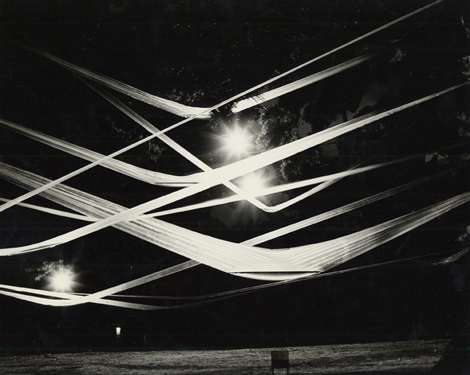while a long wait line at an LA museum is a rarity, here in New York you could easily pass an hour chatting in the line for the Met or MoMA or merge with the crowds in Chelsea. Late spring, the visceral experience of looking at art together with so many other curious viewers was taken to a new level at the Guggenheim’s opening of “Gutai: Splendid Playground” (February 15–May 8, 2013). Not only one of the best exhibitions of 2013, but a top show of all time for me. The energy of the crowds milling about the museum’s rotunda and meandering up its curving passageways mirrored the spirit of the work.
This exceptional exhibition, co-curated by Alexandra Munroe and Ming Tiampo, will hopefully correct the egregious mash-up of Eurocentrism and narrow-minded scholarship that left Gutai, the renowned Japanese avant-garde collective, relatively unknown in the U.S. After all, European and American counterparts like Fluxus and the Situationists have made their mark here. Formally known as The Gutai Art Association and active in Japan from 1954-1972, Gutai artists collectively and individually mounted public events and interactive installations long before either was the norm, playfully and vigorously experimenting with form and material, technology and the body, electronics and earth, to expand and challenge the often invisible but widely accepted boundaries that define art, and specifically, that distinguish art from the everyday goings-on of life.

Motonaga Sadamasa, Work (Water), 1956, Installation view: Outdoor Gutai Art Exhibition, Ashiya Park, Ashiya, July 27–August 5, 1956 © Motonaga Nakatsuji Etsuko, courtesy Motonaga Document Research Office
Perhaps one of the biggest successes of “Gutai: Splendid Playground” is that the museum showcased such wildly experimental and often ephemeral works that took place within an institutional—literally and metaphorically—framework without losing Gutai’s radically creative and enthusiast soul. And yes, the crowds helped. Viewers young and old took up chalk to make their mark on a re-creation of a work by Gutai founder Yoshihara Jiro, Please Draw Freely (1956/2013), a wall erected in the lobby with chalk hanging on strings inviting viewers to draw, write and imagine. A few levels up, guests waited in a line stretching along the spiraling hallway to insert a dollar and get their own mini-artwork in the stunningly forward-thinking live vending machine, a re-creation of the group’s “Gutai Card Box” (1962).
From such interactive pieces to electronic sculptures, action paintings and video documentation of early festival-like works that took place in a park in Ashiya, Gutai works (though hailing from decades ago) converse with and ignite contemporary ideas about relational aesthetics and attendant institutional efforts to make museums more accessible and community-based. But rather than casting viewers as part of their work, Gutai inspired a sense of freedom and collaboration alongside a connection to nature that seems simultaneously new and primal.
One work that could have proven problematic to re-install in a museum setting is Motonaga Sadamasa’s Work (Water), 1956/2011. Originally created for a park, where clear tubes filled with water were suspended among the pine groves, this version consists of polyethylene tubes filled with colored liquid and suspended across the massive vertical column of the museum, reflecting rays of sunshine. The re-creation has—if not the same effect—a dramatic and almost whimsical one, demonstrating Motonaga’s nuanced dexterity in moving from nature to museum; though indoors, the work draws attention to the elements of space and light.
Some of the pieces, including the action-oriented paintings of Shiraga Kazuo such as Untitled (1957), made by painting on the floor with bare feet, and Challenging Mud (1955), created by rolling naked in mud, and Murakami Saburo’s Work (Six Holes) (1955) resulting from the artist bursting through layers of paper with his body, resonate with other movements of the time, primarily Abstract Expressionism in the U.S. But others, such as two standouts, Yoshida Minoru’s mesmerizing electronic sculpture, Bisexual Flower (1969), and Atsuko Tanaka’s Electric Dress (1956), a garment covered in dozens of brightly colored light bulbs, are not only innovative for their time but continue to resonate as new ideas today.
In the context of its social and political history, Gutai’s ingenuity and risk-taking is extraordinary. Founded in 1954, the group included 59 artists over its 18-year history, consistently challenging traditional modes of viewing and making art. Gutai performances, interactive installations, paintings, sculptures, public events and its widely circulated publication, Gutai, celebrated free thought, innovative play, and the human impulse to move and imagine. At a time when the world was still reeling from World War II, and Japan itself transforming out of a seven-year occupation by the Allied forces and into a world economic power, these artists created work in complete opposition to both the propagandistic aesthetic of the war years and the vitality of the market looming on the horizon, exploring what it means to be in a body, to move, live, and experience space and time, change and technology.
Info: web.guggenheim.org/exhibitions/gutai/


